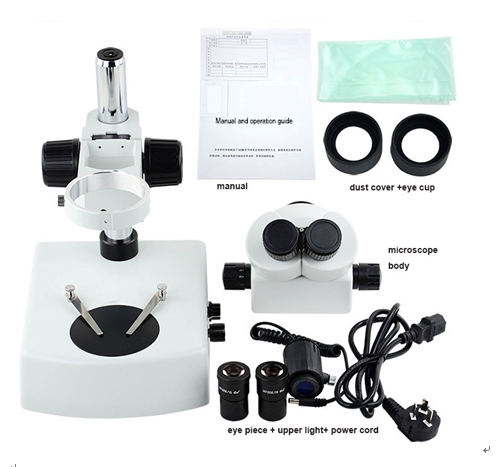Stereo microscope accessories
Every component of the stereo microscope has its own function. The parts included with this type of microscope can vary greatly depending on the configuration and uses it will serve. Each part of a stereo microscope accessories is labeled in the diagram below. This example is a typical classroom type stereo microscope with track stand and built-in illumination,Stereo Microscope accessories mainly list below, but more than these.Stereo microscope accessories are spare parts
Stereo microscope accessories
2.1 Stereo Head: This is the moveable top portion of the microscope and the stereo head holds the two adjustable eyepieces.
2.2 Ocular Lens: These are the eyepieces through which the viewer looks at the specimen. The eyepieces are typically set at 10x magnification. It is also possible to upgrade to a higher magnification level.
2.3 Diopter Setting: It compensates for the focusing differences between the left and right eye. Setting it correctly prevents eye strain.
2.4 Objective Lens: Stereo microscopes have two separate objectives, each one connecting to one of the eyepieces. The eyepiece and the objective lenses collectively determine the magnification of the microscope. They can have a fixed single objective, a rotating multiple lens turret or a zoom. It allows you to change the magnification levels depending on the applications.
2.5 Focus Knob: Stereo microscopes usually have one focus knob. Helps move the head of the microscope up and down to bring a sharp image of the object. Most dissecting microscopes have standard “rack and pinion” focusing. Rack is the track with teeth and pinion is the gear that rides on the teeth. The knob helps the pinion move along the rack.
2.6 Stage Clips: Stage clips help to hold the slides or other thin objects in place on the stage.
2.7 Stage Plate: It is located directly under the objective lens. It is where the specimen is placed for viewing. Some stereo microscopes have reversible black and white stage plates to provide appropriate contrast with the object being viewed.
2.8 Illumination: Many microscopes have both top and bottom lighting. Some microscopes only have one source of illumination, top or bottom. The top lighting shines down on the specimen and reflects light off them. The bottom lighting transmits light up through the stage to show translucent specimens.
stereo microscope accessories
list above, but more than above, due to with the development, the microscope become more professional

When use a Stereo Microscope?
With a dissecting microscope one can work on a specimen in real-time while it is still being observed. Unlike the typical compound microscope, a dissecting microscope has a longer working distance that allows for dissecting objects or even perform microsurgery. Biologists can use these microscopes to do dissections, botanists to study plants, and pathologists to perform dermatological examinations.
Stereo microscope magnification helps sort and visualize peripheral surfaces in three-dimensions which allows for a thorough examination of objects. Stereo microscopes are used by technicians to repair circuit boards, paleontologists to clean and examine fossils, technicians to perform mud logging, specialists to analyze fabric and textiles, or anyone that wishes to view or work on small objects.
Stereo microscopes can be configured for any use. Various stands and mounts are available including boom stands, articulating or flex arms, plain stands, track stands, table mounts, and more. Additionally, microscope illuminators provide a more defined and illuminated view of specimens.
Visits: 0
